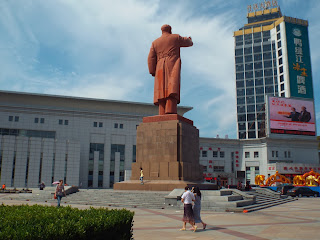"Dandong is a prefecture-level city in southeastern-eastern Liaoning province, and is the largest Chinese border city, facing Sinuiju, North Korea across the Yalu River, which demarcates the Sino-Korean border. The two cities are connected by the Sino-Korea Friendship Bridge. North Koreans often gather close to the river's edge, waving to foreigners... There is a rarely used ferris wheel in Sinŭiju that tourists are able to see from across the Yalu River". - Wikipedia
There are two bridges between Dandong, China and Sinuiju, North
Korea. One is broken, its grey flagstones coming to an unceremonious end
halfway across, left in a state of destruction since the Korean War.
Fifty metres upstream, lorries trundle slowly back and forth
across the colourfully-lit Sino-Korean Friendship Bridge in a steady procession
of import and export between the People’s Republic of China and the Democratic
People’s Republic of Korea.
The promenade along the river on the Chinese side – known as the
Yalu River Scenic Area – is a lively place. I walked along the waterfront. It
was busy with people enjoying the refreshing, cool temperature of the late
August evening. There was so much going on, it was difficult to register it
all. People dressed in Korean traditional costume posed for photographs in
front of the river. Stands sold barbecued mushrooms; others fake North Korean
money alongside cigarettes and little key rings bearing the flag of South
Korea.
Large groups of men and women of varying ages took part in
communal aerobics on the big open areas adjacent to the promenade, some making
patterns with their movements using day-glo pink strips of material. Two men
walked around the square drawing calligraphy using a wet sponge in the shape of
a nib attached to the end of a broomstick. Another man with deformed legs
played a melody on an acoustic guitar.
I heard the chimes of the bell at Westminster Abbey. Was someone
watching BBC World News with the volume turned up? The noise came from a
house-sized replica of the clock tower at the Houses of Parliament.
All the while, a big, bright full moon shone through the haze
over the elusive land on the opposite bank of the river.
I walked past the bridge and took a right turn towards the
interior of the city, aiming for the railway station. The streets here were
poorly lit, the pavement broken. The buildings big, square, grey, stained. Like
an inhabited Hashima Island. People sat outside playing cards or eating and
drinking.
I arrived at the station, a big, clean, modern affair with the
two characters that spell “Dandong” illuminated in a blaze of red above the
entrance. In the square in front of the station stands a 25-metre tall statue
of Mao, that brutal old bastard, raising his right arm in a magnanimous gesture
and looking overdressed for the season in a long, flapping overcoat.
Beyond, the cranes and half-built skyscrapers provide the
contrast between Mao’s China and the modern economic powerhouse it now is, a
country where even a border outpost has a population of well over one million
people.
It is possible to walk on to the broken bridge. When you reach
the end, you stand closer to Sinuiju than to Dandong. You can see the Koreans
going about their business; almost close enough to think you can solve the mystery of what is
going on there, but not quite. The inscrutable dirt roads and squat, grubby houses don’t
look much in comparison to the Dandong skyscapers. But seen from this distance
of just a few hundred metres, their secrets remain intact.








